Seeing Through the Eyes of a Documentary
By Chen Chih-an (陳芝安)
Photos provided by Yuan-Liou Publishing
Abridged and translated by Syharn Shen (沈思含)
Seeing Through the Eyes of a Documentary
By Chen Chih-an (陳芝安)
Photos provided by Yuan-Liou Publishing
Abridged and translated
by Syharn Shen (沈思含)
A Journey of Discovery
I share my ten years of experience making documentaries in this book which covers six major topics—finding the subject, choosing the main character, deciding on the events, interviewing skills, structure of the story, and further implications.
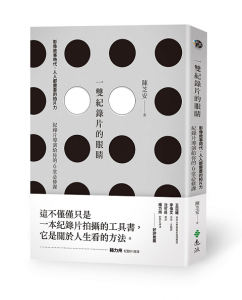
The Eyes of a Documentary is not just a reference book for documentary filmmaking, but also an exploration of the different ways of seeing the world.
The first—and also the toughest—challenge when making a documentary is finding a subject. Both Hollywood directors and experienced documentary filmmakers go for the subjects that they care about the most, feel closest to, or have the most struggle with.
As for the main characters in the documentary, I have found that those who truly leave an impression are the people who found inspiration, experienced a sudden realization, or have a heartfelt lament about life.
If every single day of our ordinary lives is a grain of sand in the river, then the selected events for a documentary are dust of gold sifted from the sand. In a documentary, some events happen after waiting, some are recreated, some take place due to an extraordinary encounter, and some are simply sand in the river—an essential part of our lives. The most important thing to keep in mind is that each selected event must carry meaning or serve as symbol.
The process of interviewing characters requires deep listening and dialogue. When you devote 100% of your attention to your interviewee, engaging them with great patience and empathy, what you get will be beyond anything you have ever imagined.
Regarding the story's structure, there are infinite ways to tell a story. You can use narration in chronological order, pose a problem to be solved, adopt an elaborate opening and introduction, piece parts and scenes together, deliberately create a sense of break and rupture, etc. I think what's most important is to practice as you go along. Watching your documentary several times after editing as well as getting feedback from both experts in the field and general audiences are good ways to help you find the right structure to tell your story.
The final part is a documentary's implications, which is my favorite topic for discussion. What implications does your documentary have? How are implications made? And what implications do you get from other movies and documentaries? The answers to these questions are closely related to one's experiences in life, which differ from one person to another.
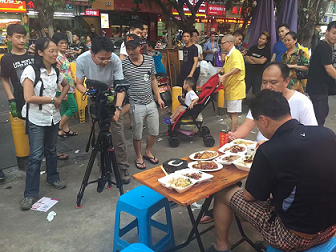
When filming a character, what's most exciting is the moment when we capture the person's stance in life. This picture was taken as we were filming a down-to-earth Taiwanese businessman for Gold Rush Dreamers in China.
Perspective Is Key
The point of view of a documentary is essential—how we observe a person, how we see an event, and how we interpret a phenomenon. Every time I arrive to a new shoot, I feel quite agitated, and sometimes even after I've started shooting for a while, I'd still be restless because I haven't found the right perspective yet. It's actually not difficult to record an event or conduct interviews as they come by with hard work and interaction. But, to find a perspective to "read" a character takes constant deliberation.
One time, I was shooting for a documentary program on Tzu Chi's recycling volunteers in southeastern Taiwan. The subject of the program was recycling. Remember, the subject is simply to help define the documentary, so what's actually central is the main character. We found an elderly recycling volunteer—Lai Pan Shun-mei (賴潘順妹), and we call her Grandma Buns since she sold vegetarian buns for a living. We were drawn to her story and personality. First, her story had a good visual element. Picture an elderly lady over eighty still working to support herself by riding a bicycle around to sell buns. Second, though her life was harsh, Grandma Buns possessed a sense of optimism and humor seldom seen among the elderly.
So, we decided to film her. One day, we captured her in a rather miserable state, shouting and selling buns at six a.m. in the pelting rain. Back at her home, we also shot a scene of her making buns as she talked to us, and we got to witness the optimistic and humorous side of her. She said that her Chinese zodiac sign is the rat, and rats are the smartest of all, so even though she can't read and didn't go to school, she understands all the ways of life and how to interact with others. As she spoke, her unique personality started to come through. When we filmed her working at the recycling station, Grandma Buns was full of energy, remained standing while she worked, and offered her seat to other volunteers. She even bent down and demonstrated how she planted rice seedlings when young. She had everyone laughing.
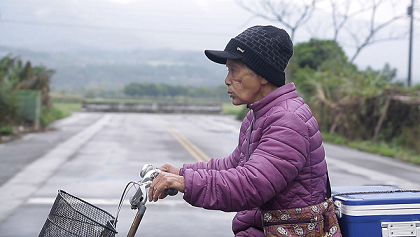
When you focus wholeheartedly on your interviewee, you will be greatly rewarded. Pictured is Grandma Buns.
If you think that planting rice and Chinese zodiac signs are irrelevant to the subject of recycling, then you are truly missing out. We are often too serious and focused on achieving our goals that we may overlook gems in life that are shining right in front of us. Japanese filmmaker Hirokazu Koreeda wrote that the world needs things that are not useful, for if everything must have a purpose, we'd be so exhausted that we'd not be able to breathe. For me, the things that are not useful refer to the materials that we originally thought were irrelevant to our subject. We may ask what does Chinese zodiac signs and planting rice have anything to do with recycling? Yet, these are the things that add depth to Grandma Buns' character. Grandma Buns' role as a recycling volunteer fits the documentary program's subject of recycling, but I think the main theme for this episode is actually her optimism and resilience in the face of life's hardships. Long after I have filmed her, I still vividly remember her and her distinct personality.
Trust Your Instinct
After documenting people for a while, you'll know if a person you've been talking to for about thirty minutes will be the main character for your documentary or not. This subjective decision has to do with your previous experiences in making documentaries as well as your own interests and preferences. The main character in Transitioning, a documentary film on hospice care that I co-directed with Hsieh Hsin-Chih (謝欣志), was head nurse Chen Mei-hui (陳美慧). A colleague of mine watched the film, and he simply said to me: "It feels like you're filming yourself."
After I decided on making a documentary on hospice care, a colleague introduced Chen to me. After talking with her for an hour or so, we felt very connected. She was a casual person who didn't bother about trivial matters. Yet, when talking about her work and experiences in end-of-life care, her story is gripping, and she has her own views and opinions that have been shaped by her own experiences and religious faith. My co-director and I were both thrilled to have found a great character to take us into the world of hospice care.
When we started shooting, we discovered that Chen had a very special ability. In the hospice ward with death looming at every corner, she carried herself with calm and ease, and even spoke and laughed out loud. When we first brought our camera and equipment into the ward, we were almost tiptoeing as we didn't want to disturb the sadness we thought was appropriate for this space. We'd lower our voice when we spoke and dared not to smile, thinking that we would be stared back. So, you can imagine our surprise when Chen sneaked up on us from behind, happily chatted with the patients, greeted the patients' family with warm smiles, and even joked with an unconscious patient. When she checked on a male, intubated patient who was unable to speak or control his eye movements, Chen stroked his bald head and told him: "You're so handsome and your skin is so smooth. It's smoother than mine!" She even let out a laugh. We watched her as we shot the scene, full of doubts in our minds.
We later learned of Chen's approach for hospice care. She saw the ward, a space we found intimidating, like any other ordinary space, and she treated the dying patients and their sad family members as normal people. Once, Chen was caring for a cancer patient who had on his neck a large tumor that gave off a foul odor. As she was changing the dressing, she joyfully told him about the songs she was listening to. The patient could not speak, so he communicated with his hands, and both of them joked around for a while. While shooting the scene, the smell from the tumor was so overpowering that I had to hold my breath. The tumor looked quite horrible, and many viewers covered their eyes when they watched this scene. But Chen was relaxed there, joking with this patient, and we filmed their interaction as it unfolded naturally. This scene needed no narration or explanation, for it clearly showed Chen's unique stance on hospice care.
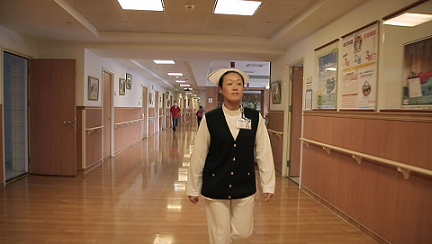
Chen Mei-hui, head nurse of a hospice ward, is the main character in Transitioning. The choice of main characters for a documentary reflects the interests and preferences of the filmmaker.
To present a viewpoint to see a character in a documentary, we need to discover his or her unique qualities, and focus on these as we collect more materials. This way, the character will stand out vividly. Remember that you cannot depend on your character to tell you about his or her unique qualities, for these qualities are to be observed through the eyes and perspective of your documentary.
Seeing Characters as Human Beings
From September 2017 till December 2018, Hsieh and I had a wonderful opportunity to make a documentary film on Tzu Chi volunteers in Taidong in southeastern Taiwan. It was six years after I have left Da Ai TV, one of Tzu Chi's media, and it gave me another chance to learn about Tzu Chi from its volunteers working in the frontlines. If Tzu Chi were a gigantic tree standing tall with its green leaves spreading out, the strong and intertwined roots that support this large tree are Tzu Chi volunteers, working hard day and night in different corners of Taiwan.
For the location and setting of our documentary film, we chose Taidong for its beautiful and magnificent nature landscapes. It can offer space for healing and can also serve as a metaphor for the film. In Taidong, there is a high percentage of the population moving out in search of opportunities, and its residents also have the lowest life expectancy in all of Taiwan. A group of local Tzu Chi volunteers have been helping people in need there for many years.
Before we started shooting, we had already decided that we were going to view Tzu Chi volunteers as human beings, rather than portray them as faultless and selfless saints. Since they are human beings, they have emotions and desires; they err and fall ill. Just like everyone, they are also in search of answers in life. What makes them different is that they have aspired to help others in need and chose to do so as their mission in life, caring for others as if they were their own family members—not an easy thing to do. This documentary film, Walking Dharma, is not an overview of Tzu Chi's history and development in Taidong, much less a propaganda or glorification of Tzu Chi's values and ideals, nor it is meant to encourage people to do good. Our approach follows Koreeda's portraying the world not as black and white but with different shades of grey. It doesn't present a binary world in which people are either heroes or villains, but tries to depict lives following different kinds of values.
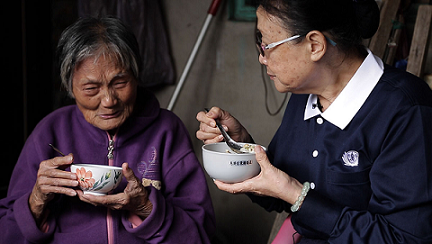
In Walking Dharma, a 67-year-old Tzu Chi volunteer pays a visit to an 87-year-old elderly who lives alone.
Perseverance and Patience is a Must
Husband and wife Yu Hui-xiong (余輝雄) and Song Mei-zhi (宋美智) are two Tzu Chi volunteers featured in Walking Dharma. We chose them as two of our main characters for their humor and indomitable will. As we were preparing to start filming, we received the shocking news that Yu was diagnosed with lung cancer. Regardless, I was determined to film them and was ready to try everything to persuade them if they declined to continue with the shooting. In making a documentary, once you have decided on your main character, it is important to persevere and stick to your choice.
So, we began filming the couple doing Tzu Chi's work as they paid home visits to people they've been regularly caring for many years. It's a good approach to starting filming your main characters engaging in activities. They are less nervous and it allows time and space for the filmmakers and the characters to get to know one another and form a connection.
While filming the home visits, two events unfolded wonderfully, because in a short period of time, there was a dramatic turn of events. The first event happened during a visit to Lin Zhao-lan (林照蘭), an elderly woman who lived alone and had trouble moving around. The couple arrived at her gate during daytime and rang her bell, but no one answered the door. They shouted her name but no one answered. Suspense was in the air. One hour later, they returned, and still nothing. Yu was worried if the elderly woman has passed out. Now, there was a sense of crisis. Later in the evening, the couple returned again to Lin's house. Still, no one answered, so they sought help from the police, who borrowed a ladder to climb into the house. They found the 70-year-old lady sitting on a chair, exhausted, for she has not eaten a thing for the entire day.
This event is complete with characters, a setting, a problem, and a solution. In a documentary, events like this come by with luck and patience as well as not letting any opportunity slip by. Filming a documentary is sometimes like placing a bet. No one knows if you'll succeed and whether you should continue to invest more time, energy, and resources.
Show, Don’t Tell
In Story: Substance, Structure, Style, and the Principles of Screenwriting, Robert McKee wrote: "Authenticity depends on the 'telling detail.' When we use a few selected details, the audience's imagination supplies the rest, completing a credible whole." McKee also advised not to treat the audience as children by bombarding them with explanations, but instead to let them see, think, experience, and form their own conclusions.
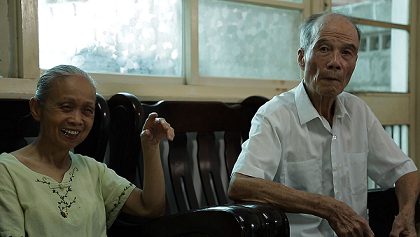
In their 60s and 70s, Tzu Chi volunteers Song Mei-zhi and Yu Hui-xiong have experienced poverty in their lives, but chose to help others in need.
If we want to tell our audience that Tzu Chi volunteers, regardless of their age and health issues, devote themselves to caring for others in need, but only show clips of them giving presents to people and having conversations with them, the visual materials are not enough to prove our point. Only when we show enough details from unfolding events and display the changes in the outcome can we support what we want to say. If this is the case, then nothing needs to be said or explained at all. In Walking Dharma, our hope is to guide the audience to experience and discover the unknown, be in the uncertainty of not knowing what will happen next, and have curiosity and even expectations. So, when the outcome is finally revealed, the audience will experience the event as if they were there in person.
The Challenge of Telling About the Past
The other event has to do with a girl and her family that Yu and Song have been caring for a decade. 17-year-old Cai Jing-tian's (蔡進添) father was a veteran and her mother is from China. When Yu first visited the family, Cai's father was on his deathbed, with three oxygen tanks standing beside. The family of four was out of money and was soon going to be out of food too. Feeling for the poor family, Yu quickly withdrew money with his ATM card to tide them over. After Cai's father passed away, Yu and Song have continued to care for this family, helping them apply for monetary assistance, supporting the depressed mother, and encouraging the two kids to study hard.
Cai said that Yu and Song visited them once or twice a month, and when her mother was unwell, the couple would visit them almost every week. Cai performed well in school and was one of the students who got the highest grades. With Yu and Song's care and support for a decade, the family fared better, and Cai was soon going to take her college entrance exams.
When making a documentary, how can we show the stories of Cai's family and their relationship with Yu and Song on screen? Often, the telling of past events is a troublesome issue for filmmakers. Discovery Channel and National Geographic Channel sometimes spend a fortune to employ actors to reenact historical events. Many filmmakers also go for a much cheaper alternative of recreating the past through stylized representations and dramatizations.
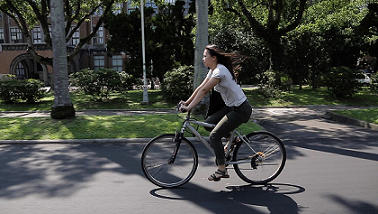
Pictured is Cai Jing-tian riding a bike at National Taiwan University. With the help from Tzu Chi volunteers and her own hard work, her life was transformed.
In Walking Dharma, we did not employ these methods, but tried to present Yu's and Cai's stories, their past, and their ten-year relationship by weaving materials together against the backdrop of Yu's and Cai's situation in life. Yu was an aging old man battling with cancer, and Cai was a hopeful young girl ready to embrace new opportunities in life.
Events Can be Created
As we collected materials to present Yu's and Cai's stories, we planned a surprise visit from Cai to Yu and Song. Filming the visit was a bit like shooting a reality show. We had no idea what would happen. With a gift and a card, the young girl's visit to the couple resulted in a moving scene. Yu and Song were happily surprised and filled with joy when Cai told them that she was admitted to Taiwan's top university. From this planned visit, we learn that events do not always need to be waited for, but can also be created as long as it is well planned out and its purpose is appropriate. Also, if your main characters willingly agree to it, just go ahead, create the event, and let it unfold.
Contact Us | Plan a Visit | Donate
8 Lide Road, Beitou 11259, Taipei, Taiwan
886-2-2898-9999
005741@daaitv.com
©Tzu Chi Culture and Communication Foundation
All rights reserved.
